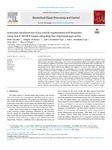Automatic simultaneous ciliary muscle segmentation and biomarker extraction in AS-OCT images using deep learning-based approaches

Use este enlace para citar
http://hdl.handle.net/2183/36340
A non ser que se indique outra cousa, a licenza do ítem descríbese como Atribución-NoComercial-SinDerivadas 4.0 Internacional
Coleccións
- Investigación (FIC) [1656]
Metadatos
Mostrar o rexistro completo do ítemTítulo
Automatic simultaneous ciliary muscle segmentation and biomarker extraction in AS-OCT images using deep learning-based approachesAutor(es)
Data
2024-04Cita bibliográfica
Goyanes, E., de Moura, J., Fernández-Vigo, J. I., Fernández-Vigo, J. A., Novo, J., & Ortega, M. (2024). Automatic simultaneous ciliary muscle segmentation and biomarker extraction in AS-OCT images using deep learning-based approaches. Biomedical Signal Processing and Control, 90, 105851. https://doi.org/10.1016/j.bspc.2023.105851
Resumo
[Abstract]: Recent clinical studies have emphasized the importance of understanding the morphology and mechanics of the
ciliary muscle. The ciliary muscle plays a vital role in various functions related to the anterior segment of the
eye, including the regulation of intraocular pressure and the maintenance of the shape of the crystalline lens. To
advance research in this area, we propose a fully automated methodology for the segmentation and biomarker
measurement of the ciliary muscle in two different scan depths (6 mm and 16 mm), which are commonly
used by clinicians to analyze biomarkers. Our methodology aims to provide repeatable, and immediate results
through an exhaustive analysis of different network architectures, encoders, and transfer learning strategies.
We also extracted a comprehensive set of relevant biomarkers, including parameters that provide essential
information about its behavior during the accommodation process, overall dimensions, and biomechanical
properties. These biomarkers can help clinicians and researchers in the diagnoses and monitor of different
ocular diseases such as glaucoma, myopia, and presbyopia and develop new therapeutic strategies, potentially
leading to more effective treatments and improved patient outcomes. Our methodology achieved accurate
qualitative and quantitative results, with high accuracy values of 0.9665 ± 0.1280 and 0.9772 ± 0.0873 for the
best combinations for 6 mm and 16 mm, respectively. Our proposed system provides a valuable and automatic
tool for clinicians and researchers in the segmentation and analysis of the ciliary muscle in AS-OCT images.
Palabras chave
CAD system
AS-OCT
Ciliary muscle
Segmentation
Biomarkers
Deep learning
AS-OCT
Ciliary muscle
Segmentation
Biomarkers
Deep learning
Versión do editor
Dereitos
Atribución-NoComercial-SinDerivadas 4.0 Internacional
ISSN
1746-8094
1746-8108
1746-8108






